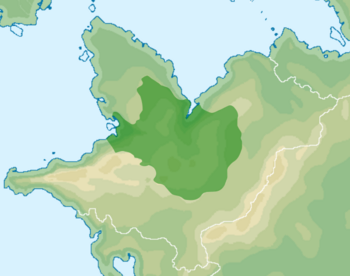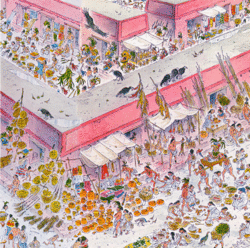Chaan Dynasty
Chaan Chaan Nimja | |||||||||
|---|---|---|---|---|---|---|---|---|---|
| 300 BC - 250 AD | |||||||||
 A map of the Chaan Mutul at its greatest extend | |||||||||
| Capital | Yux | ||||||||
| Common languages | Classical Mutulese | ||||||||
| Religion | White Path | ||||||||
| Government | Monarchy | ||||||||
| K'uhul Ajaw | |||||||||
| Historical era | classical | ||||||||
| 340 BCE | |||||||||
| 300 BC | |||||||||
| 315 BC–300 BC | |||||||||
| 250 AD | |||||||||
| |||||||||
The Chaan dynasty (Mutli : Chan Nimja) was the second divine dynasty of the Mutul, preceded by the 50 years long Nakabe Revolt, and then followed by the War of the Princes. It lasted for over 470 years, from 320 BC to 250 AD, and is considered a golden age of the Mutulese history.
The period saw a number of limited institutional innovations. The Chaan government centralized the prerogatives traditionally reserved to rulers, such as the control of the roads and of waterways, with strengthened control over marketplaces, banks, and various lenders, while the aristocracy continued to be responsible of the transport of goods and products from markets to markets, from the producer to the consumer. Science and technology during the Chaan period saw significant advances including the process of papermaking and the use of negative numbers in mathematics.
Etymology
The Dynasty was not named after its founding clan's name, but instead from it's glyph-emblem, representing a snake. The Ahk Family, so called because many of its members had the "Ahk" in their glyphic name, chose the snake, Chan or Kaan depending on the dialect, to honor the Vision Serpent, the gateway to the divine realm and a reminder of the family's origins in Divination.
History
Foundation
Traditional Myth
According to traditions and the records kept by the Chaan, the Ahk lineage began when one of K'o's, the First K'uhul Ajaw, daughters gave birth to a son, Siyaj Ahk, fathered by a minor divinity of the underworld. After proving the veracity of her words to her father, by quoting in the Underworld's language her lover's titles, she was given the direction of a Temple covering a door to the Underworld. She gave birth during the travel, and the child was carried in a turtle shell. During his childhood, the half-god, great-grandson of Chak and son of a god of the Underworld, proved to be a great Oracle, capable of communicating with both the upper and under worlds. He became famous for his wisedom and prophecies, and was even invited to his uncle's, the new K'uhul Ajaw, court despite his unclear paternity and the possible threat he could become to the Divine Lord's authority. He nonetheless served as the main priest and oracle of the court, given the charge of Kaminyajunlyu main temple and the direction of the associated school for the elite. He notably became the personal teacher of the B'ah Ch'ok Ajaw and then his main advisor.
It was through Siyaj Ahk's origins that the Ahk Lineage explained their gift in divination and long held positions as oracles and seers. They would remain important nobles at the Paol'lunyu court for all of the Dynasty's duration. During the second half of the Dynasty, the Extensive Period, an Ahk and close friend of the Ka Lineage received lands from the latter in the recently conquered north, with the task of establishing a city capable of both protecting the western border of the Mutul against aggressors and serving as a trade hub with the Chik'inli. The legend says that it's in a ritually-induced vision that the perfect location for that city was revealed to the Ahk, who then founded the city of Yux. Yux would remain a major vassal to the Ka and their city of Nakabe, protecting their western flank against ennemies and serving as a major source of both funds and men for their wars.
But ultimately, Yux loyalty's to Nakabe was weakened by the latter's growing centralization, always increasing demand, incessant warfare, and complete abandon of its vassal against the Yakalmek Kingdom, a nominal allies of the Ka who nonetheless continued to raid and harass Yux. This led to Iztam K'an Ahk's rebellion in 340 BC, supported by Izapak, the rival of Nakabe.
Yux-Izapak Co-Dominion
Itzam K'an Ahk's son, Wabak'el Chaan married Lady Ek Janab, solidifying Yux's alliance with Izapak. When the K'uhul Ajaw of Izapak died without an heir, it's Lady Ek Janab who secured the throne for herself. Thus both Mutal ended up in a co-dominion, ruled by two K'uhul Ajaw married to one another, once Wabak'el Chaan rose to the throne of Yux too.
This joint rule would last from 327 to 300 BC and would see the defeat of the Ka Dynasty and the de-facto re-unification of the Mutul in 315 BC. However, it's not until the death of both monarchs that their son, Yax Chaan Ahk would unify both crown and claim the Divine Lordship of all of the kingdom, officialy starting the Chaan Dynasty.
Society and Culture
The Chaan became a prime example of the Mutulese Trifunctional hypothesis, which postulate that at least until the Ilok'tab Dynasty, if not after, the Mutul was divided into three classes or castes : the priests-scribes, the trader-nobility, and the artisans-commoners. The K'uhul Ajaw was at the apex of that society. Ranked immediately below were the Yajawob, generally translated as "vassal lords", "Princes", or "Dukes" depending on the authors. Yajawob could be from the same dynasty as the K'uhul Ajaw or from local lineages, a common case in remote regions where the central powers had difficulties imposing itself. The rest of society was composed of nobles lower than the Yajawob and all commoners, plus the slaves.
Market Network System
The Chaan relied on a strong middle class of skilled and semi-skilled workers, artisans, and landowners. Governing these "Commoner-producers" was a smaller class of specially educated merchant governors who would direct regional economies based upon simple supply and demand analysis. This aristocracy would thus ensure both the circulation of trade goods and its protection, legitimizing their rule. At the top of the structure was the K'uhul Ajaw and an his array of advisers who would manage trade between Yajawils but also with other kingdoms, ensure that regions remained stable, inject capital into specific sectors and authorize construction of large public works (even if that last prerogative was devolved to regional governors). Advisors and government agents came from a specialist class, called nowadays the "Priests-scribes", which included clerics but also professions like artists, mathematicians, architects, advisers, and astronomers who would sell their services and create luxury goods based upon their specific skill set.
Market economy was predominant during the Chaan Dynasty. Cities were highly integrated and urbanized. Small towns did not need to take part in long-distance trading and limited trade to local exchange. This created a multitiered structure, where locally produced goods would be exchanged at local markets, to be exported to regional ones, and then be spread all thorough the kingdom depending on the analysis of the demand made by the merchant-aristocracy. The most important markets were also the political centers of the Chaan Dynasty as the seats of the Yajawob. There is a strong parallel between economic and political structures, as Yajawils corresponded roughly to a "Regional Market" and all the associated smaller "local markets". This structure was given the name of the "Market Network System", highlighting the dual nature of the Mutulese aristocracy, both political and financial.
Justice
Under the Yajaw was the Halak Winik and then the Batab. The Batabs were administrators of smaller towns or of urban districts in the larger cities. They were responsible for carrying out the laws issued by the K'uhul Ajaw or the decrees of the Yajaw and Halak Winik above them. They also served as judges for their towns and adjudicated civil and criminal cases. Court cases were generally handled swiftly in public meeting houses known as popilna, generally located near or at the market. Witnesses were required to testify under oath and the parties were represented by individuals who functioned as attorneys. Decisions made by the Batabs could be appealed and the case would then go the Halak Winik, but it seems to have been an uncommon procedure. The victims could pardon the accused, thus reducing their punishment. Sentences were carried out immediately by the tupiles as the Chaan did not maintain prisons and preferred corporal punishments on public spaces, up to and including the capital punishment.
If a crime occurred that affected an individual in another town, the batabs in the two towns would work together to ensure that issue was resolved. The Batabs generally acted independently, but would consult with the Halak Winik on serious cases. Halak Winiks and Yajaws could decide to personally handle a case, but this was a procedure generally reserved for cases involving the nobility.
The Chaan criminal laws were severe. Murder, rape, incest, treachery, arson, and acts that offended the gods were punishable by death. However, it distinguished between intentional and accidental acts. For example, individuals who were found guilty of homicide were sentenced to death. If an individual was found guilty of manslaughter however, he was sentenced to repay the family of the victim by giving up one, or more, of his slaves. If the criminal was a minor, he could be sentenced to slavery. Nobles who were found guilty of crimes were forced to have their faces permanently tattooed as a symbol of their crimes.
Adultery was considered a criminal offense. Married women who committed adultery were publicly shamed and their lovers were stoned to death. Their husbands had the option of leaving the marriage and finding a new spouse. Married men who committed adultery were sentenced to death unless their extra-marital affair was with an unmarried woman.
Pardons were available for criminals. Adulterers could avoid punishment by being pardoned by the injured husband, and families of murder victims could demand restitution in lieu of capital punishment.

